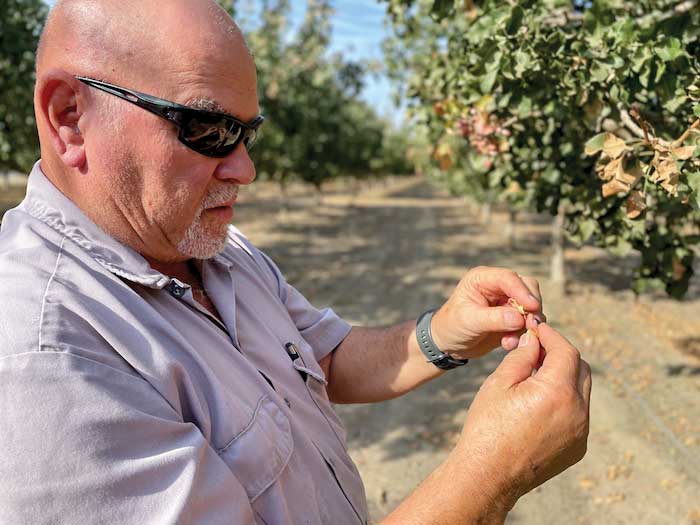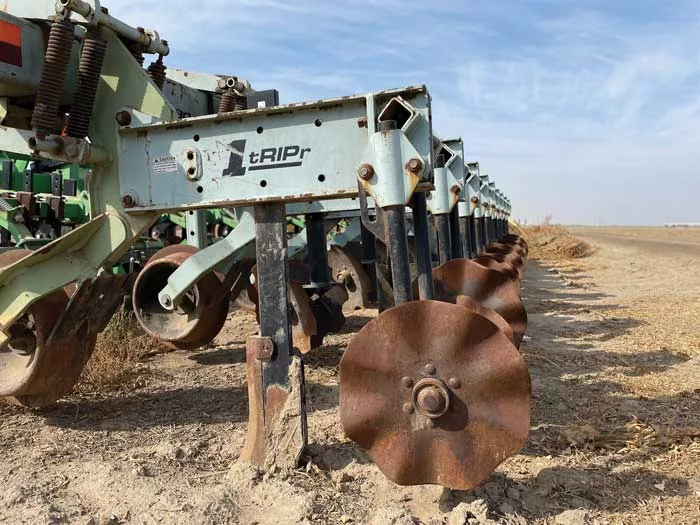Tom Barcellos is a strip-till trailblazer on the West Coast.
“California and strip-till don’t traditionally go together, even though I’ve been doing it for 23 years now,” he says.
The Tipton, Calif., native was the first in his area to move away from the plow when he started no-tilling 26 years ago. Now, he estimates 60% of all corn production in his area is grown under conservation tillage practices.
Barcellos remembers his no-till origin story like yesterday.
“We were right in the middle of double cropping behind wheat forage and getting ready to plant corn for silage,” he recalls. “We were running 9 tractors in different fields when one of our main ones went down. There were no rentals available, and the neighbors were busy running their own. A good friend of mine in the seed business said to me, ‘There’s this no-till planter they’re talking about up north.’”
It was a brand-new John Deere 10-row MaxEmerge no-till planter. Barcellos gave it a shot.
“We started in an irrigated field that was beginning to dry up,” he says. “We made 3 rounds, and my co-worker said, ‘Maybe it’s not going to work. This ground is too dry and tight.’ I looked at it and said, ‘Keep going.’
“We finished planting those 80 acres and started water right behind it. We had enough to germinate the seed as it grew 2-3 inches out of the ground 10 days later. We were amazed by the results.”
The 80-acre field yielded 27 tons per acre, shattering its previous high. Barcellos was immediately sold.
Switching to Strip-Till
No-till was very beneficial, but Barcellos quickly found strip-till to be the better option in California’s hot, dry climate. He started strip-tilling most of his acres just 3 years after his first no-till experiment.
“Strip-till gives us more of a cushion,” Barcellos says. “When I was all in on no-till, we were basically running the planter 20 hours a day, and most of those hours were at night because the soil starts tightening up at 2 p.m. We had to shut down for 4-6 hours until it got dark.
“Strip-till made everything a lot easier. Granted, we’re running another tractor, but on certain soils, we get corn out of the ground sooner and better. Over time, the soils improved because we weren’t beating them to death anymore. No-till still has its place in my region, but everybody started leaning toward strip-till because of the increased planting flexibility and better water infiltration.”
West Coast Challenges
Today, Barcellos stays busy managing two dairy operations with his wife, Felomena, their daughter, Bridget, and son-in-law, Matthew Kidder. Barcellos mainly produces feed for 2,000 cows on the family’s 1,800-acre irrigated operation — strip-tilling corn for silage, no-tilling small grains, and growing pistachios and citrus. He also hauls commodities for other local dairy operations.
Farming in California comes with a unique set of challenges.
“It’s not a very agricultural-friendly state to do business,” he says. “There are regulations after regulations after regulations.”

ALWAYS ON THE CLOCK. Tom Barcellos opens a pistachio from one of his trees in late October. “Busy season” never ends for the Tipton, Calif., strip-tiller who manages 1,800 acres of diversified cropping, primarily growing feed for his two dairies. Photo Noah Newman
The state adopted the Sustainable Groundwater Management Act in 2014, which limits the amount of water that can be pumped out of the ground, Barcellos says.
“It’s creating some real challenges for farmers,” he says. “Thankfully I’m in an irrigation district with surface water, but I don’t have to drive very far to get to some neighbors who aren’t part of an irrigation district and their only source for water is pumping. There are places being sold for that very reason.”
Water management was already a big challenge. Barcellos’ farm gets around 9 inches of rain annually, and most of it comes in the winter.;
“We don’t raise crops on our rainfall — we raise crops on our irrigation,” he points out.
15% of Barcellos’ ground was unplanted last summer because there wasn’t enough water available. Faced with heavy regulations and skyrocketing input costs, some farmers are relocating their operations to other states.
“I have a friend in Nebraska who used to run a dairy operation here,” he says. “I had a friend west of Fresno who’s now in Tennessee. Many have gone to Texas and Idaho. There are several in Utah.”
But Barcellos can’t pack up and take his talents elsewhere, nor does he want to. He was born and raised in the Central Valley of California, unlike his friends, who were transplants.
“I have a lot of history here,” he says. “My entire family is here. I have 3 daughters here. My grandkids are already running equipment. I can’t just pick up and run.”
Strip-till has proven to be the answer to many of his problems. Cutting down the number of field passes makes a huge difference when dealing with unfathomably high fuel and labor costs.
“It’s helped tremendously,” Barcellos says. “We only use 2 tractors in the field now — 1 for the strip-till bar and 1 for the planter. We’re paying $7.19 per gallon for diesel fuel today in California. Not too long ago it was $4. By switching to strip-till, we cut our field trips in half, which ultimately helps us save a third of the fuel we’d burn if we still farmed conventionally.
“It’s a different world out here, but I wouldn’t trade it for anything…”
“The cost of labor has skyrocketed, and there are too many opportunities for people to stay home. They keep extending and increasing unemployment benefits in California. There are a lot of people who just don’t want to work.”
‘Busy Season’ Never Ends
Barcellos has 45 employees spread across his various operations. He needs all the help he can get because unlike other areas of the country, the Fresno area climate doesn’t allow for much down time.
“People in other states freak out when I tell them we’ll get 8 cuttings of alfalfa every year,” Barcellos says. “The first one might be chopped off and put in a bag for feed. Every month after that we’re cutting and baling hay. We’re busy all the time working year-round. In California, there are over 400 agricultural crops raised. It’s a different world out here, but I wouldn’t trade it for anything.”
Barcellos no-tills small grains like wheat and oats typically before Thanksgiving and no later than mid-December. The grains are double cropped back to corn for silage on the same fields for 4-6 years before being rotated to alfalfa.
“We drill either oats or wheat into the alfalfa stand with my John Deere 1590 no-till drill,” Barcellos says. “Once that crop comes off and we harvest it, the soil is so mellow from that root structure in the top that we can come back and strip-till corn into it beautifully.”
Barcellos says his area has “every type of soil you can imagine”— a big reason why he uses 2 different strip-till bars. His primary one is the same Orthman 8-row 1tRIPr he purchased over 20 years ago when he made the switch to strip-till.
“It’s simplified,” he says. “It doesn’t have row cleaners because we don’t have a lot of top residuals, just shanks and wavy coulters in the back that cut strips 6-7 inches wide. The wavy coulter does a good job of opening soil. We don’t run any kind of compaction in the back because the soil tilth is better in those areas.”
On tougher soils with lower organic matter, Barcellos runs his Bigham Super Duty strip-till bar.
“It has dual shanks for different types of soils and a pack wheel in the back,” he says. “We use it in areas that require a little more tillage.”
Barcellos builds his strips in the spring right before planting corn for silage. He puts down a starter fertilizer mix of nitrogen (N), phosphorous (P), potassium (K) and micronutrients with his John Deere 1700 MaxEmerge planters. He has an 8-row and a 10-row planter, both equipped with wavy coulters on the front and fertilizer units.

LEGEN-DAIRY. Tom Barcellos has 2,000 cows at his two dairy operations. He uses manure from the dairies for fertilizer, spreading it across fields at agronomic rates determined by soil tests. “The natural fertilizer we get from the dairies has been beneficial because we have a considerable amount of high-pH alkali soils,” he says. Photo Noah Newman
About 2 months into the corn cycle, Barcellos knifes in a sidedress application of UAN 32% with micronutrients.
“We have a fold-up fertilizer bar that we use to sidedress corn,” he says. “In California, we don’t have wide-open spaces and massive giant fields. We have fields that might be 40 or 80 acres, but at the end they’re small-turn rows. Since we have irrigation systems, there are pipelines and vent pipes you need to get around, so the fold-up bar makes it convenient.”
Every field is soil sampled annually to determine fertilizer rates, and Barcellos cuts back on N considerably when dairy lagoon water is available for irrigation.
“We put on what we need when we need it,” Barcellos says. “Inputs are just too expensive not to manage as closely as we can.”
Conservation Tillage Lessons Learned
Barcellos learned early on in his conservation tillage journey that no-till and strip-till weren’t “set it and forget it” magic bullets. A lot of management is required to make it work. Some of his neighbors learned the hard way.
“My 2nd year no-tilling I planted 3,000 acres between my operation and the operations of neighbors who wanted to try it,” Barcellos recalls. “Everybody took for granted that it was easy. Some of them failed — it was their fault for not being in the field and irrigating.
“I tried to coach people as much as I could, but I couldn’t get around to everyone. Some guys started knocking no-till and quit doing it. But 3-4 years later, they were back and doing it right because they saw how successful it was for others. Now, all my neighbors are no-tilling to some degree.”
Attention to detail is key to success, but no two years are alike. Barcellos says that’s his biggest lesson learned from nearly 25 years of strip-tilling.
“I learned early on that change is constant,” he says. “I think that’s what keeps us engaged and makes everything interesting. We look at different ways to improve every year. We’ve got so many options when it comes to equipment and technology available to make strip-till work in California.”







